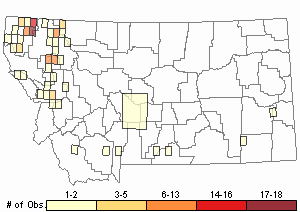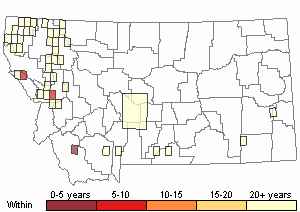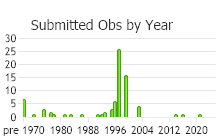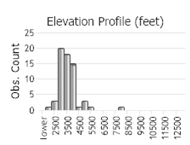View in other NatureServe Network Field Guides
NatureServe
Montana
Utah
Wyoming
Idaho
Wisconsin
British Columbia
South Carolina
Yukon
California
New York
Pretty Mat Moss - Eurhynchiastrum pulchellum
Other Names:
Eurhynchium pulchellum
General Description
Plants: Pleurocarpous (Vitt 1988), growing in open to crowded mats (Lawton 1971), sometimes extensive (Crum and Anderson et al. 1981), green or green with yellow tones (Lawton 1971), shiny. Stems rarely reaching 13 cm in length, with branching crowded and erratic, possessing a central strand; pseudoparaphyllia with narrowly-angled apices. Branches rarely reaching 17 mm (FNA 2014), creeping or strongly curving upward (Crum and Anderson et al. 1981).
Stem Leaves: Upright or spreading to about 45 degrees, a little cupped, usually not pleated except in larger leaves, widely deltoid and somewhat ovate, widest at or within the proximal 10% of the leaf length, 0.5-2.6 mm in length, 0.4-1.8 mm in width (FNA 2014), the apex narrowly-angled (Crum and Anderson et al. 1981); base extending down the stem; leaf edges flat or curved back and downward below (FNA 2014), occasionally the margins not as strongly dentate as in the branch leaves (Lawton 1971); costa over half to 85% of the leaf length with a dorsal spine at the end (FNA 2014).
Branch Leaves: Smaller than the stem leaves, and also smaller at the stem tips (Lawton 1971), the more crowded leaves upright, those more distant often spreading widely (Crum and Anderson et al. 1981), usually 0.2-1.3 mm in length, seldom reaching 1 mm in width, the tip dull (FNA 2014) and frequently twisted (Crum and Anderson et al. 1981); costa over half to 90% of the leaf length (FNA 2014).
Leaf Cells: Laminal cells very slender; alar region small and somewhat well-defined (FNA 2014), the cells nearly square, oblong, or oddly-shaped, the walls a little thickened (Lawton 1971).
Eurhynchium pulchellum var. pulchellum: Stem leaves sometimes reaching 1.3 mm in length and those of the branches to 1.1 mm, not or only a little pleated (FNA 2014).
Eurhynchium pulchellum var. barnesii: Present in Montana (Elliott and Pipp 2016; FNA 2014). Stem and branch leaves mostly longer than in var. pulchellum, sometimes reaching 2.6 mm and 1.9 mm in length respectively, distinctly pleated (FNA 2014).
Diagnostic Characteristics
Eurhynchiastrum species have a terminal spine on the dorsal face of the costa, a characteristic that is absent in Rhynchostegium species (FNA 2014).
Range Comments
Montana Range
Eurhynchium pulchellum: Known in Montana from Carbon, Carter, Cascade, Custer, Flathead, Glacier, Granite, Lake, Lincoln, Madison, Meagher, Mineral, Missoula, Park, Powder River, Ravalli, Sanders, and Valley Counties (Elliott and Pipp 2016).
Variety pulchellum: Known in Montana from Cascade, Flathead, Lake, and Mineral Counties (Elliott and Pipp 2016).
Variety barnesii: Known in Montana from Flathead, Lake, Ravalli, and Sanders Counties (Elliott and Pipp 2016).
North American Range
Variety pulchellum: Known in all Canadian provinces and territories except PE, in nearly all states of the USA, and in Mexico (FNA 2014).
Variety barnesii: BC and AB in Canada, AK, WA to MT, CA, and CO in the USA (FNA 2014).
Observations in Montana Natural Heritage Program Database
Number of Observations: 118
(Click on the following maps and charts to see full sized version)
Map Help and Descriptions
Relative Density

Recency



 (Observations spanning multiple months or years are excluded from time charts)
(Observations spanning multiple months or years are excluded from time charts)
Habitat
Variety pulchellum: Soil, stone, rotting wood and tree bottoms in forests, protected perpendicular stone faces, forested and wet inclines of gulches, exposed soil of dry steppe. Occurring from lowlands to 10,500 feet elevation (FNA 2014).
Variety barnesii: Soil, stone, and rotting logs. Occurring around 1640 feet elevation (FNA 2014).
Reproductive Characteristics
Pseudomonoicous or dioicous, the stems and rhizoids of large female plants supporting epiphytic dwarf males, or male plants similar to the females and growing intermixed in the same clumps or in separate clumps. Seta russet, mostly smooth, 10-18 mm tall. Capsule 1.5 mm in length (FNA 2014), greatly inclined to level, a little shrunken below the opening (Crum and Anderson et al. 1981); peristome allowing capsule mouth to open in low humidity (FNA 2014); endostome light brown; cilia knobby (Crum and Anderson et al. 1981). Calyptra lacking hair (FNA 2014).
Variety pulchellum: Sporophytes, which are rare, are thought to occur only in forest habitats (FNA 2014).
Stewardship Responsibility
References
- Literature Cited AboveLegend:
 View Online Publication
View Online Publication Crum, H.A. and L.E. Anderson. 1981. Mosses of Eastern North America. 2 volumes. Columbia University Press, New York. 1328 pp.
Crum, H.A. and L.E. Anderson. 1981. Mosses of Eastern North America. 2 volumes. Columbia University Press, New York. 1328 pp. Elliott, J.C. and A.K. Pipp. 2018. A Checklist of Montana Mosses (1880-2018). Updated 3 January, 2020. Montana Natural Heritage Program, Helena, Montana. 73 pp.
Elliott, J.C. and A.K. Pipp. 2018. A Checklist of Montana Mosses (1880-2018). Updated 3 January, 2020. Montana Natural Heritage Program, Helena, Montana. 73 pp. Flora of North America Editorial Committee, eds. 2014. Flora of North America North of Mexico. Volume 28. Bryophytes: Mosses, Part 2. Oxford University Press, Inc., NY. xxi + 702 pp.
Flora of North America Editorial Committee, eds. 2014. Flora of North America North of Mexico. Volume 28. Bryophytes: Mosses, Part 2. Oxford University Press, Inc., NY. xxi + 702 pp. Lawton, E. 1971. Moss Flora of the Pacific Northwest. Hattori Botanical Laboratory. Japan: Yamabuki-cho, Shinjuku-ku, Tokyo. 362 pages plus appendices.
Lawton, E. 1971. Moss Flora of the Pacific Northwest. Hattori Botanical Laboratory. Japan: Yamabuki-cho, Shinjuku-ku, Tokyo. 362 pages plus appendices. Vitt, D. J. Marsh, and R. Bovey. 1988. Mosses, Lichens & Ferns of Northwest North America. Seattle, WA: University of Washington Press. 296 p.
Vitt, D. J. Marsh, and R. Bovey. 1988. Mosses, Lichens & Ferns of Northwest North America. Seattle, WA: University of Washington Press. 296 p.
- Additional ReferencesLegend:
 View Online Publication
View Online Publication
Do you know of a citation we're missing? Elliot, J. C. 1993. Second checklist of Montana mosses. Unpublished report. U.S. Forest Service, Region 1. Missoula, MT. 45 pp.
Elliot, J. C. 1993. Second checklist of Montana mosses. Unpublished report. U.S. Forest Service, Region 1. Missoula, MT. 45 pp. Flowers, S. 1973. Mosses: Utah and the West. Brigham Young University, Provo, Utah. 567 p.
Flowers, S. 1973. Mosses: Utah and the West. Brigham Young University, Provo, Utah. 567 p. Lawton, E. 1971. Keys for the Identification of the Mosses on the Pacific Northwest. Reprinted from 'Moss Flora of the Pacific Northwest'. Published as Supplement No. 2 of the Journal of the Hattori Botanical Laboratory. Nichinan, Miyazaki, Japan. 66 pp.
Lawton, E. 1971. Keys for the Identification of the Mosses on the Pacific Northwest. Reprinted from 'Moss Flora of the Pacific Northwest'. Published as Supplement No. 2 of the Journal of the Hattori Botanical Laboratory. Nichinan, Miyazaki, Japan. 66 pp. Malcolm, B., N. Malcolm, J. Shevock, and D. Norris. 2009. California Mosses. Nelson, New Zealand: Micro-Optics Press. 430 pp.
Malcolm, B., N. Malcolm, J. Shevock, and D. Norris. 2009. California Mosses. Nelson, New Zealand: Micro-Optics Press. 430 pp.
- Web Search Engines for Articles on "Pretty Mat Moss"





